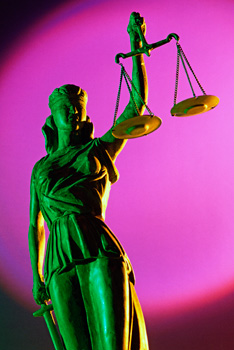 Oct. 2, 2013 – A long-awaited bill drafted by the Wisconsin Judicial Council contains comprehensive amendments to Wisconsin’s Criminal Procedure Code. The bill, 2013 Assembly Bill 383, has a colorful history and is the subject of an upcoming hearing.
Oct. 2, 2013 – A long-awaited bill drafted by the Wisconsin Judicial Council contains comprehensive amendments to Wisconsin’s Criminal Procedure Code. The bill, 2013 Assembly Bill 383, has a colorful history and is the subject of an upcoming hearing.
This article provides a brief history of the drafting process and guiding principles. It also explains the significant changes to criminal procedure included within the bill, which was introduced Sept. 20 by Rep. Jim Ott at the request of the Wisconsin Judicial Council.
Why the Judicial Council, and Why the Change?
The Wisconsin Judicial Council (Judicial Council) was responsible for the last comprehensive revision of the criminal procedure statutes, in 1970. In 1967, the Wisconsin Legislature funded a Judicial Council Criminal Rules Committee “to prepare a complete redraft of those statutes which deal with procedure in criminal cases.”
That effort resulted in a bill enacted as Chapter 255, Laws of 1969, which became effective on July 1, 1970. The bill created chapters 967 to 976 of the Wisconsin Statutes and stated its purpose as follows: “[This bill] attempts to codify statutory and case law in systematic form beginning with the initiation of the criminal process and ending with post-conviction remedies.” This mirrors the intent of the current revision.
In 1992, the Judicial Council created a Criminal Procedure Committee as one of its two ongoing study committees. The Committee's charge was to once again study a complete revision of the Wisconsin Criminal Procedure Code.
Public Hearing Oct. 11 at Marquette Law School
A public hearing on the criminal procedure bill, AB 383, is tentatively scheduled for Oct. 11, 2013 at Marquette University Law School (time TBD).
In the years leading up to the creation of the Judicial Council’s Criminal Procedure Committee in 1992, several criminal procedure issues had been referred to the Judicial Council and delayed in anticipation that they would eventually be dealt with together.
One of these referrals was a request from the now-Uniform Law Commission to evaluate the Uniform Rules of Criminal Procedure, which are based on the American Bar Association’s Standards for Criminal Justice.
A number of Judicial Council members also believed the criminal procedure statutes needed a complete review. Provisions were hard to find, organization had broken down as new provisions were added, and new case law needed to be codified. The situation appeared to be very much like the one that had existed before the 1970 revision.
Guiding Principle and Drafting Process
The guiding principle for the newly created committee was that current procedures should be reflected in the statutes and presented in a manner that makes them easy to find and understand; a well-intentioned, if inexperienced, prosecutor, defense lawyer, or judge ought to be able to rely on the statutes as a guide to criminal procedure.
 Prof. David E. Schultz (U.W. 1972) is a Professor of Law at U.W. Madison. Prof. Schultz chaired the committee that drafted the bill.
Prof. David E. Schultz (U.W. 1972) is a Professor of Law at U.W. Madison. Prof. Schultz chaired the committee that drafted the bill.
 April M. Southwick (Hamline 1998) is an attorney for the Wisconsin Judicial Council, Madison.
April M. Southwick (Hamline 1998) is an attorney for the Wisconsin Judicial Council, Madison.
The Criminal Procedure Committee was composed of Judicial Council members who elected to participate, augmented with ad hoc members selected for their expertise in criminal law. Membership was diverse, and included district attorneys, assistant attorneys general, public defenders, private defense lawyers, judges, and academics.
The Committee's progress was severely interrupted when; effective July 1, 1995, the Judicial Council's budget was eliminated. The Council's two staff positions were also cut, meaning that valuable research and drafting services were no longer available to the Committee. Although the Committee's progress was seriously hampered by the loss of staff, the volunteer committee members continued their work.
The Committee proceeded through the criminal procedure code, statute-by-statute, and word-by-word. It operated by compromise and consensus, reaching general agreement on each section before it was approved.
The group of volunteers completed a draft of proposed amendments in 1999. Their work product carried the unanimous endorsement of the Judicial Council Criminal Procedure Committee. Not everyone was wholeheartedly in favor of every item; not everyone preferred each item exactly as it was drafted. But, on balance, all committee members endorsed and recommended adoption of the draft without reservation.
The draft was forwarded to the full Judicial Council where it was unanimously approved on Dec. 10, 1999 (Justice Crooks abstaining). The draft was then forwarded to the Legislative Reference Bureau (LRB). However, without the assistance of staff, the technical creation of a bill proved slow and difficult for the volunteer group of Council members.
Finally, 2007 Wisconsin Act 20, restored the Judicial Council’s independence, and re-appropriated funding for a full-time staff attorney. With the aid of staff, the Council was able to renew its efforts to work with the LRB to create a draft bill. Over the next several years, the draft bill, which exceeded 360 pages, went through many revisions.
Finally, with a nearly-complete product in-hand, the Judicial Council spent months editing the bill and authoring additional amendments to bring it up-to-date with current practice and case law. Members completed their work in the summer of 2012.
A Summary of Significant Changes in the Bill
A major purpose of the bill is to reorganize and clarify current law, but a number of substantive changes are also made. The most significant clarifications, reorganizations, and substantive changes are described below.
Encourage Prompt Disposition of Misdemeanors
While some counties have efficient procedures in place for dealing with misdemeanor prosecutions, encouraging more prompt disposition statewide was an important goal.
Achieving this goal depends as much on a change in approach and legal culture as on statutory change. Several changes are included in the bill to facilitate the prompt resolution of minor cases:
Encourage the use of citation over formal arrest;
Encourage arrest and release over detention;
Eliminate the long form complaint by allowing endorsement of the citation and its use as the charging document;
Require access to police reports at the first appearance, and allow discovery even prior to first appearance.
The purpose of these changes is to avoid unnecessary pretrial detention and eliminate statutory obstacles to prompt disposition of misdemeanors by doing away with the time-consuming practice of drafting long complaints.
The time saved can be better spent on providing early discovery and preparing to resolve the case at or shortly after the initial appearance, without the delay occasioned by repetitive and unnecessary court appearances and pretrial conferences.
Elimination of the Preliminary Examination in Felony Cases
Early in its deliberations, the Criminal Procedure Committee decided to propose elimination of the preliminary examination. The Committee concluded that the preliminary exam was of extremely limited utility today. Its official function, to identify weak cases and dismiss them, is rarely carried out. This is especially true in light of court decisions holding that credibility of witnesses is not to be considered and competing inferences are not to be weighed.
The unofficial functions – previewing witnesses, obtaining discovery, evaluating the strength of the case – are of limited value in light of current limits on scope of the preliminary and in light of the high number of waivers of the preliminary. Again, in some counties, the preliminary continues to work moderately well, but even then its value is outweighed by the resources consumed: court time; the time of witnesses, often involving overtime for police officers; and, the time of prosecutors and defense lawyers.
The functions of the preliminary examination, official and unofficial, can better be served directly. The bill includes several provisions that are intended to do so:
Encourage earlier and more complete discovery (e.g. police reports at the initial appearance). Discovery is allowed even prior to the initial appearance;
Allow a motion for pretrial dismissal to address the rare situation where uncontroverted evidence shows the case cannot be proved.
Clean Up Troublesome Statutes
Several statutes that were either hard to understand or the sources of practical difficulties were revised to provide clarity:
Provisions regarding consolidation of charges from more than one county are modified to make the rules easier to locate and understand;
Discovery rules: the substance of current rules is retained but is reorganized to make it more accessible and understandable;
Bail provisions are reorganized to make them more accessible and understandable;
Mental issues relating to competency to stand trial and the insanity defense: new Chapter 975 reorganizes material found in a few extremely long statutes in current law, breaking the material into separate statutes and adding captions makes the material more accessible and understandable.
Incorporate New Provisions
Several statutes are created to provide new authority or to clarify procedures. Some examples follow:
Allow the district attorney to apply for an order requiring a financial institution to disclose a person's status as a depositor – intended to facilitate access to this basic information without going through formal procedures such as a John Doe;
List the ways a person's appearance in court can be secured – intended to clarify the available procedures;
Allow the district attorney to release a defendant on bond before the initial appearance – intended primarily for cases when the defendant is likely to be released without monetary conditions after the initial appearance;
Codify case law defining the prosecutor's authority to dismiss a complaint;
Create a single, general, statute authorizing deferred and suspended prosecution agreements to replace several separate statutes that purport to govern agreements in specified types of cases;
Describe the effects of the different pleas available to the defendant by codifying current law to clarify the issues;
Codify current law relating to motions to dismiss asserting that a statute is unconstitutional – intended to avoid unwitting waivers by failing to make proper service;
Codify remedies for the so-called Bruton situation where one codefendant's statement is not admissible as to the other codefendant.
Codify current law allowing jurors to ask questions, in the discretion of the court;
Codify current law relating to the acceptance of stipulations;
Require an individual jury poll in all cases, to avoid unnecessarily litigating whether the defendant knew of and waived the right;
Codify current law relating to the defendant's presence at postconviction proceedings;
Create a process to obtain evidence before trial and to address practical problems relating to production;
Codify current law and practice relating to obtaining nontestimonial information from the defendant;
Create a process to obtain nontestimonial discovery from third parties.
Next Step
On Sept. 20, 2013, Rep. Jim Ott, 23rd Assembly District, introduced the bill (AB 383) in the Assembly. It was referred to the Committee on Judiciary and an informational public hearing was held on Sept. 26, 2013. Another public hearing is tentatively scheduled for Oct. 11, 2013 at Marquette University Law School (time TBD).
The Judicial Council looks forward to working with the Legislature to adopt this important and long-anticipated bill to enhance our justice system. A properly codified criminal procedure code will improve the quality of legal practice, reduce the number of errors and appeals, and increase court efficiency and effectiveness.
